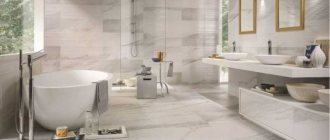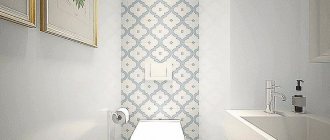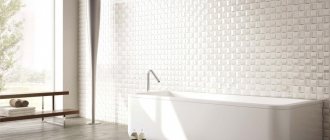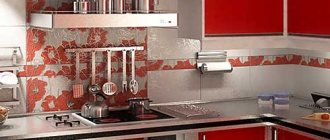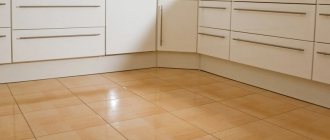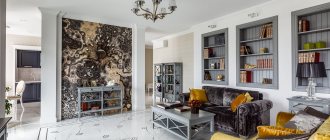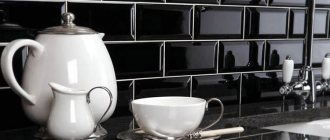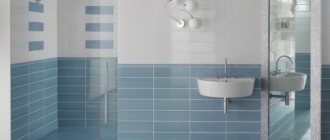Tile has been used for a long time and consistently as a finishing material for the bathroom, toilet, kitchen, and swimming pool. This is a convenient, practical and beautiful material, the range of which is replenished almost daily. Wall tiles have slightly different characteristics than floor models, but more often they are produced as a set, with a suitable design. You can spend a lot of time choosing a pattern and color, because there are thousands of types. But when the choice is finally made and the boxes of tiles are delivered home, an unpleasant fact may be revealed - some tiles are of different sizes. With a skillful approach, this nuisance may not be a reason to return the product.
Features of modern bathroom design
Different types of tiles on the floor and walls are characteristic of a modern interior design. Therefore, check out what criteria such a design must meet:
- A complete rejection of classical editing. Nowadays, structural materials with a matte and heterogeneous texture are in fashion.
- Laying standard single-color tiles in different patterns with a combination of facing materials of the opposite tone.
- The use of decorative items: friezes, borders, tiled plinths. A selection of drawings to match the color of the interior.
- Use for finishing finished collections in the bathroom: with ornament, decoration, unusual arrangement, intersecting seam.
- Using the horizontal masonry method to visually expand walls with diagonal floor placement.
- The use of vertical wide friezes is justified. This approach will help “raise” the ceiling and make the room lighter and more spacious.
Do not forget that for modern interior solutions it is important to highlight the internal corners of the room. Therefore, use tiles of a contrasting tone in relation to the base for their cladding. For example, for a room in a pastel color palette, a material is chosen to highlight the corners of red, green, and black. In these places, laying elongated decor is also encouraged. It will make the perimeter of the room perfectly smooth and hide design flaws.
Ornament in the bathroom with brown and patterned tiles Source design-vannoy.com
Important! The use of black tiles should be thoughtful and organic. It is best to combine it with a red ornament, a panel or a collection of drawings in the area of functional areas.
Vertical stripes in the bathroom of contrasting colors Source 3dlancer.net
Decorating a bathroom - how to combine tiles correctly so that it doesn’t look cheap
If such requirements as moisture resistance, hygiene and resistance to cleaning and abrasive substances are critical for a room, then this room is a bathroom, and tiles are the only possible option for wall and floor coverings for it. You may be asking: “Why is that?” I answer))
It is impossible to find a material more suitable for a bathtub than tiles - easy care for the entire period of use, and this is more than one year.
And most likely, not even 5. At least 10 years. For this reason, you should choose tiles especially carefully, since, unlike wallpaper, no one has been able to re-glue tiles in a couple of days.
And since not everyone understands how to choose the right tiles, because there are nuances in every matter, this article should ease the pain of creativity in making a decision, the result of which in the form of a new luxurious bathtub will delight you for many years.
When choosing a tile, the main thing to remember is that you need to choose it not by the photo on the website, but by touching it with your hands, feeling the texture and understanding how it will look already laid on the floor or wall, whether the edges will meet and how beautiful it will look.
It is also important to pay attention to the characteristics of the tiles:
- The size of the tiles must be correctly indicated on the packaging;
- Integrity of the material: the tile must be free of chips and cracks, the absence of foreign inclusions is also important;
- Surface resistance to mechanical abrasion;
- Withstands temperature changes;
- Moisture resistance;
- Resistance to cleaning chemicals;
- The quality of the materials used in its decoration - the design must retain its saturation and color throughout its service life;
- Anti-slip effect.
We decide what color scheme our bathroom will be in. And when choosing this criterion, designers recommend the following:
- White classics seem boring to many, but if the bathtub is not impressive in size, it’s a win-win option - dilute it with bright inserts and the boredom will disappear;
- Green or blue tiles evoke a feeling of freshness and coolness;
- Natural wood shades, coffee or beige create a feeling of warmth and comfort;
- Bright colors - red, gold or turquoise - are good to use to create accents, but if you love oriental style and the bathroom is larger than standard sizes, you can use these colors as the main color scheme;
- Black color - looks chic if, as in the previous case, if the room is large and there is a window. In the opposite option, it will reduce the already small room and create a pressing effect;
- Do not forget that a light top and dark bottom, just like large slabs on the floor, will visually reduce the size of the room; To visually enlarge the room, the designer’s recommendation is vertical stripes and small tiles on the floor.
Now we need to decide on the following question: will our bathroom sparkle with gloss, or will the tiles be matte, or maybe succumb to the temptation and tile the bathroom with textured tiles? Let's figure it out...
Glossy tiles:
The most common choice so far. It is easy to care for, and due to its surface, the tile creates an optical effect that looks harmonious against a light background, but if the tile is dark, it hurts the eye.
Mirror tiles:
Mirror tiles are also available for sale. It is used to visually increase the space of the bathroom. This tile replaces a mirror with mirror tiles. Sometimes, to raise the ceiling, mirror tiles are used to decorate the ceiling.
Matte tiles:
It is visually perceived better because it does not reflect light, but splash marks stand out more. Due to its rough surface, these tiles are often used as floor tiles.
Over the last 8-10 years, tiles that imitate natural textures have been gaining more and more adherents. This is wood, concrete, stone, marble, travertine or iron. It looks elegant, stylish and expensive.
When choosing tiles, do not forget two important characteristics of the surface - roughness and water absorption.
Designers recommend tiles with zero permeability - glass tiles and porcelain tiles, which can be used without any doubt in the bathroom.
To ensure that ceramic tiles can also be used for tiling bathrooms, they are made dense in production and covered with glaze. They also produce matte ceramic tiles.
Roughness is important when choosing floor tiles, since there is a high probability of slipping and injury in the bathtub.
The roughness effect is achieved by applying a special granular coating to the tiles or using relief patterns.
The recommended roughness coefficient for floor tiles is 0.75. With all the advantages of this type of tile, it is important not to forget that the downside of safety will be some inconvenience during cleaning - dirt accumulates on such tiles more quickly.
Also, when choosing a bathroom style, the size of the tiles is taken into account.
By size, tiles are divided into 4 categories:
- Large is a tile, one of the sides of which is longer than 40 cm, regardless of shape.
- Medium - tiles with a side length from 15 to 30 cm.
- Small - a tile with a size on one side of 6 to 10 cm (possibly, but rarely 15 cm).
- Mosaic is a special type of tile (glass or ceramic) with sides from 1x1 to 5x5 cm.
For several years now, “hog” tiles have become popular. The sizes can be from 7.5x10 cm to 8.5x28.5 cm, but the most popular size is 10x20 cm. The peculiarity of this finish is that the tiles look like bricks with authentic chamfers.
True, it is in these places that dust and limescale deposits accumulate, which will be difficult to clean.
It is better to select square tiles in large sizes - from 60x60 cm, since squares of smaller sizes will look, so to speak, vintage, unless it is an accent insert.
Patchwork is an option. It can also be a vintage style bath. In other cases, you should use tiles with an aspect ratio of 3 to 1. The size of the tiles should correspond to the size of the bathroom.
If you will be installing a shower enclosure and for the best visual solution, it is worth considering rectified tiles.
We are not talking about the type of material or production method, but about the method of cutting tiles, which will make it possible to achieve the narrowest seams between the tiles when tiling. European companies are now switching to this particular version of “high precision” tiles.
When you choose tiles for the bathroom, you should pay attention to many subtleties and nuances - from the appearance and size to the performance characteristics of the tiles, go through kilometers of stands with samples and still make it - this is the right choice.
Which will lead you to the renovation of your dreams, which will delight you with its quality, style and performance for many years.
It is for this case that these recommendations are written. Dream boldly, and may the tiles be with you!!!
Popular layout options
The most difficult thing is to choose a pattern that can be used to decorate the walls and floor in the bathroom. If you create the ornament correctly, it is interesting to combine the seams between the tiles, you can get a unique effect. It will emphasize the sense of taste and add the finishing touches to the interior.
Correct placement of tiles in the bathroom from the corner horizontally Source m.my.mail.ru
Masonry from the corner
This method involves installing one tile in a row from the corner. From here they lay out the entire wall, using tiles without a pattern with the same surface. When you reach the next corner, there is usually empty space left. It is finished with cut fragments of tiles from the same collection. As a result, we may see a corner filled incorrectly. In appearance, it visually supports the ceiling and makes it higher. To ensure that such an element is clearly visible, a contrasting shade is used for grouting joints.
Placing tiles in the bathroom, starting from the center of the wall to the sides Source plitkahelp.com
Correct laying from the center
Installation begins from the center of the wall. When completing a row on both sides, the last tile is not fixed. Unfilled spaces on both sides are leveled and lined with material of the opposite color. The following combinations look good: light green and orange, brown and milky, peach and pink, white and black.
Installing tiles from the center using decor in height Source folksland.net
Laying squares from the center in the bathroom Source yandex.ua
Central masonry in different directions
For such a composition, background tiles and decorative elements are used. For the entire bathroom you will need at least 3 vertical rows of them. Laying begins from the center of the wall without architectural structures (built-in niches, bulges). Having reached the end of the row, they return to the center and carry out a similar installation of tiles in the opposite direction. At the end of each line a vertical decor is inserted. The same thing is done on the other edge of the row. This composition is repeated along the entire height of the wall. You can use not only friezes and borders, but also equally cut pieces of tiles of a different color.
Each method is guaranteed to be suitable for different conditions: with curvature of walls, lack of level.
Placement with ornament
Typically, this method is acceptable for tiling the floor in the bathroom. With the correct selection of geometric patterns, a tiled carpet is created. For such compositions, be sure to use edging around the perimeter of the room. It is chosen in dark, eye-catching tones. You can continue the framing with a plinth, also made from the remains of tiles.
Floral ornament on the wall in the bathroom Source roomester.ru
Using this technology, it is necessary to accurately calculate all dimensions. An error of a few millimeters can cost a shift and visual disruption of the diagonals in the room. Designers do not recommend using ornaments on the floor in small bathrooms. This is explained by the fact that the composition should be visible at the entrance. You can't clutter it with a headset.
Using patchwork tiles for masonry in the bathroom Source plitkahelp.com
Patchwork masonry
Patchwork is used for modern and vintage styles. It looks original in the bathroom. This interior will be remembered for a long time. It is equally used for finishing floors and walls. Screens under shower boxes or bathtubs are often decorated with this design. This option should be used sparingly. Otherwise, the composition will turn out to be a kaleidoscope that hurts your vision.
Bathroom with patchwork tile decor in the functional area Source plitkahelp.com
When covering the floor in a patchwork style, the walls should be left light and monochromatic. If you want to decorate the walls in a similar pattern, then choose only one, preferably the far one. The patchwork will always be visible on it. The remaining walls are made monochromatic (as in minimalist style). A multi-colored pattern can be placed in a small fragment behind the side of the toilet, under the washbasin, between wall shelves, opposite the mirror.
Patchwork tiles for decorating adjacent walls in the bathroom Source uutvdome.ru
For narrow and elongated bathrooms where a shower is installed, you can line two adjacent walls forming a corner with a patchwork pattern. Tiles are laid on the floor in diamond shapes or small squares. They try to use a light shade of the surface, and make the seams one tone darker.
Bathroom with shower with patchwork tiles Source remontbp.com
Bathroom with tiles on the walls in the form of parquet boards Source topplitka.ru
By type of parquet or floorboard
To give the bathroom a solid appearance, use narrow tiles on the floor. It is laid in the form of parquet. For such an ornament, purchase tiles with a structure that imitates natural wood.
Parquet laying of narrow tiles in the bathroom Source vl-fasad.online
Pieces of tiles are placed in a “herringbone” or “braid” pattern. This is how a real visualization of a parquet board is obtained. When laying the floor in this way, the walls become light. Wooden objects, wicker baskets for dirty laundry, and boxes for storing bath accessories are used as decoration.
Bathroom with a gray herringbone parquet flooring Source yellowhome.ru
Honeycombed floor and walls
For this purpose, a special hexagonal tile is purchased. It is customary to lay it in combination with contrasting tiles. An excellent example: laying black and white, mustard brown, gray and beige tiles. A masonry option using three or more shades is welcome.
Using tiles with a geometric structure in the form of hundreds of two shades Source keramoteka.ru
Such tiles are easy to lay in various patterns. By joining several slabs of the same shade, you can create a flower, a polygon, or a large-scale drawing. Often, hexagonal tiles with a patchwork pattern (patchwork) are purchased for the floor.
When laying multi-faceted tiles on the floor, you don’t have to adjust or trim the material at the junction with the walls. Leaving these areas unfinished will create a dramatic border that will attract attention. It should be leveled and can be covered with a waterproofing layer to prevent moisture from getting under the floor covering.
Using a three-dimensional honeycomb pattern in the bathroom Source ariesengineering.com.au
Calm wall decoration in the bathroom with honeycomb tiles Source yandex.ru
What creates difficulties at work and how to solve the problem
The main difficulty, as mentioned above, is the large accumulation of pipes and equipment in the bathroom. How to lay tiles in a bathtub in such conditions?
First of all, you need to understand that these plumbing elements must be freely accessible. If the pipes run along the bottom of the wall, they can be covered with a box, but at the same time leave open spaces
Schematic illustration of tile laying
For walls and floors, it is important to use different schemes when performing cladding. It is important to choose the right sized tiles. You can choose models of different colors and styles. The main thing is that the modules are successfully combined:
- Horizontal. The most common option. They try to use it for narrow bathrooms. One color of tile is located halfway up the wall from the floor. White-orange, white-pink, beige-brown compositions look great.
- Vertical. This option, on the contrary, is suitable for rooms with low ceilings. The same tiles are laid in several rows up to the ceiling, then replaced with a different color. This way you can alternate and make several stripes with similar masonry, or you can divide the bathroom in half.
- Contrasting zones. For this effect, you will need several tiles of a color that will stand out against the general background of the walls. Bright highlighting can be done near functional areas.
- Placing tiles with panels. Plain tiles in a bathroom without decoration are already outdated. Now they focus on panels with patterns and floral designs. Such drawings look very beautiful with a floral frame.
- Diagonal laying. It involves covering walls or floors with square tiles placed along diagonals. This effect has a beneficial effect on visualization. The atmosphere acquires notes of freshness and an original approach to execution.
- Brickwork. The use of this option is typical for the loft interior design. Light tiles are used. The seams are grouted with a product that matches the tile or is several shades darker. It is important here that the accent is visible.
- In a cage. This option is more suitable for finishing the floor. The work is very painstaking and requires care. You will need three types of tiles: long fragments, small squares and basic squares. Large tiles are laid out, narrow fragments on four sides, and small pixel squares in the corners.
- Chess board. This method is common in bathrooms of medium size. Such compositions make the room attractive, in-depth, and original. For this purpose, tiles of contrasting colors are used: blue and green, black and white, red and purple.
Complex and offset patterns can also be used. They will require several types of tiles. It is advisable to choose options from the same manufacturer. Each tile must match in thickness for easy laying.
A few more styling options with tips from designers
You can use spectacular masonry even when performing the most budgetary repairs. Let's consider additional options for laying out tiles in the bathroom.
Laying tiles in the bathroom with painting Source yandex.by
Painting and classic tiles
In the area near the bathtub, you can line the lower part of the wall with light tiles. Everything above is covered with moisture-resistant paint. You can apply several grout colors to the tiles, creating a smoothly transitioning rainbow effect.
Laying tiles using the “notebook in a cage” method Source wallpoper.com
Checked notebook
The background laying in the room can be made from small squares. If you choose the right grout and make the seams perfectly even, you can get a wall with an imitation of a cage. To achieve this effect, you will need white tiles in the shape of 10x10 cm squares and blue or blue grout material.
Vertical laying of hog tiles in the bathroom Source forum.domik.ua
Changing Orientation
If you purchased a “hog” tile, it can be laid vertically. In this position, the design on narrow walls will look beautiful. This effect will replace the traditional imitation of brickwork. For originality, you need to make the seams thinner. To do this, purchase narrow crosses or wedges.
Imitation of parquet boards with tiles in the bathroom Source atlas-russia.ru
Parquet pattern on the wall
Herringbone wall decoration attracts attention and visualizes excess space. This design is appropriate for finishing around the entire perimeter. Sometimes a wall near the bathroom and concrete partitions in the shower are lined in a similar way. It is better to finish with narrow rectangular tiles.
Simplified masonry
If you choose a medium-sized tile, then it can be laid in the form of bricks on the wall without displacement. The tiles go strictly on top of each other. Therefore, make sure that the walls are adjusted to the level. Otherwise the defect will be visible. This cladding option is suitable for square rooms. This composition in the minimalist style is used very well. There are no patterns or ornaments provided here.
Using different combinations of tiles in the bathroom Source expert.agromat.ua
Bathroom tiles: which one to choose?
Most often, the term “tile” refers to several different coatings at once:
- ceramic (tile);
- porcelain stoneware;
- a natural stone.
Authors of the project: Eva Prunskate, Egle Prunskienė. Photo: Leonas Garbaciauskas, Raimondas Urbakavicius
Authors of the project: Eva Prunskate, Egle Prunskienė. Photo: Leonas Garbaciauskas, Raimondas Urbakavicius
Design: Artup Bureau
Design: Artup Bureau
Design: Oleg Klodt
Design: Oleg Klodt
All these coatings share key advantages, especially valuable in conditions of high humidity and temperature changes:
- moisture resistance;
- ease of care;
- durability;
- wide selection of colors, textures, shapes, sizes.
Authors of the project: Daria Misyura, Dmitry Karpenok. Photo: Sergey Krasyuk
Authors of the project: Daria Misyura, Dmitry Karpenok. Photo: Sergey Krasyuk
Design: Moonarchitectandbuilder
Design: Moonarchitectandbuilder
Author of the project: Pavel Romanov. Photo: Zinon Razutdinov
Author of the project: Pavel Romanov. Photo: Zinon Razutdinov
However, a wide choice, in addition to unlimited design possibilities, gives rise to the problem of choice. For the most part, the question of choosing the right finish is an individual one, but there are a number of recommendations that will help you make the right choice.
1. Choose finishes that are proportional to the room. In most cases, the optimal choice will be elements commensurate with the bathroom area: if the room is quite large, choose larger tiles - and vice versa.
Design: RARE Interior Design
Design: RARE Interior Design
Author of the project: Vera Gerasimova. Photo: Dmitry Livshits
Author of the project: Vera Gerasimova. Photo: Dmitry Livshits
Design: Tolko Interiors
Design: Tolko Interiors
Seamless styling is in fashion One of the exceptions to the general rule about sizes is the effect of seamless installation (for example, porcelain tiles imitating natural stone). In such cases, even in tiny rooms, larger elements are chosen to get closer to the effect of a single canvas.
Design: Ksenia Ivanova
Design: Ksenia Ivanova
Author of the project: Vera Gerasimova. Photo: Dmitry Livshits
Author of the project: Vera Gerasimova. Photo: Dmitry Livshits
3. Both conciseness and originality are in trend. Modern bathroom design is quite democratic: on the one hand, simplicity and conciseness are in fashion (for example, ordinary white square tiles); on the other hand, there is a parallel trend for unusual textures and shapes (3D tiles, scale tiles, hexagonal finishes).
Photo: Instagram @merenkova_design
Photo: Instagram @merenkova_design
Design: Vladimir Glynin
Design: Vladimir Glynin
Authors of the project: Mikhail Slobodskoy, Olga Kuznetsova. Photo: Evgeniy Kulibaba
Authors of the project: Mikhail Slobodskoy, Olga Kuznetsova. Photo: Evgeniy Kulibaba
Author of the project: Roman Leonidov, Elena Volgina, Olga Sandakova. Photo: Alexey Knyazev
Author of the project: Roman Leonidov, Elena Volgina, Olga Sandakova. Photo: Alexey Knyazev
Authors of the project: Tatyana Korneeva, Victoria Korneeva, Ekaterina Zhorina. Photo: Evgeniy Luchin
Authors of the project: Tatyana Korneeva, Victoria Korneeva, Ekaterina Zhorina. Photo: Evgeniy Luchin
Authors of the project: architects Anna Karpova, Vladimir Razdelov, Varvara Istratova (architectural bureau "LVA-Interior"). Photo: Sergey Ananyev
Authors of the project: architects Anna Karpova, Vladimir Razdelov, Varvara Istratova (architectural bureau "LVA-Interior"). Photo: Sergey Ananyev
4. Natural stone is not only marble. Fans of natural stone and its high-quality imitations rejoice: manufacturers do not cease to replenish their assortment with an ever-increasing variety of colors and textures. Indeed, in addition to the familiar granite and marble with gray veins, there are many other options.
Author of the project: Yuri Zimenko. Photo: Andrey Avdeenko
Author of the project: Yuri Zimenko. Photo: Andrey Avdeenko
Design: Tolko Interiors
Design: Tolko Interiors
Design: Olga Betsa
Design: Olga Betsa
5. A modest area does not limit the choice of color. Yes, white wall decoration will visually enlarge the room somewhat, but any other light shade will also cope with this task. Also, and this point is often overlooked, deep dark shades can work the same way: take a look at the photo below.
Photo: elnikova.com
Photo: elnikova.com
Design: Design Home Agency
Design: Design Home Agency
6. You can also combine neutral shades. Playing with color doesn’t have to be based on bright palettes: it also looks impressive within neutral shades. And the combination of light gray tiles with beige is one of the most noticeable current trends.
Design: Domestic Studio
Design: Domestic Studio
7. Color and graphics are on trend. Tiled elements are perfect for implementing the most daring design ideas related to the play of shades, graphic patterns, color blocks, and contrasting lines.
Design: Desatori
Design: Desatori
8. Bold combinations are in fashion. Designers, when choosing tiles for the bathroom (photos from 2020 clearly demonstrate this), are increasingly using bold color combinations. Spectacular, unconventional, unexpected color combinations of tiles in the bathroom are in fashion (several spectacular examples in the photo below).
Design: Tolko Interiors
Design: Tolko Interiors
Authors of the project: Dmitry Ovcharov, Boris Voskoboynikov, Maria Akhremenkova, Chantal Verheyen. Photo: Alexey Knyazev
Authors of the project: Dmitry Ovcharov, Boris Voskoboynikov, Maria Akhremenkova, Chantal Verheyen. Photo: Alexey Knyazev
There are practically no restrictions in this matter. Not only is modern design extremely democratic in matters of color, but also the bathroom and toilet are one of those rooms where deviations from the general palette of the interior of a house or apartment are quite acceptable. This means you can give full rein to your imagination.
9. Mosaic is a solution for perfectionists. Fans of installation without trimming can combine tiles with mosaics: this option will allow you to calculate the layout as accurately as possible and avoid unwanted trimming.
Photo: darianazarenko.com
Photo: darianazarenko.com
Photo: bureau17-117.com
Photo: bureau17-117.com
Combination of several techniques
If you want to make your bathroom original, you can use several masonry techniques at the same time. For example, the base is an imitation of brickwork, and the interior panel in the shower is in the form of a parquet board. You can use elite tiles with a beautiful figured shape. It is used to line the following areas: near the sink, faucets, and shower head riser.
Beautiful bathroom design with tiles Source dizajninterer.ru
We take into account the parameters of the room
In order for the selected layout to look good in the bathroom, you need to take into account several parameters. For example, for small rooms it is better to choose tiles measuring 15x15 cm or 20x20 cm. Also consider the list of important points:
- Use small and large tiles alternately or simultaneously for spacious rooms.
- In compact bathrooms, it is better to use a material with a glossy glazed surface.
- For large rooms, laying matte tiles on the floor and in work areas is relevant.
- Avoid a lot of dark colors, they can distract attention from interesting masonry options.
- Sharp tones and contrasting transitions can be used for bathrooms with showers and rooms with irregular geometry.
- A large number of decorative borders and friezes are optimal for wide bathrooms.
On a note! If you urgently need to visualize the height of the ceiling, use vertical masonry, long friezes, and highlight the corners.
Laying tiles on the floor with a matte texture and ornament Source satu.kz
Basic aspects of tiling
The methods of laying tiles that give the room a unique unique look depend on the shape and color of the finishing material, as well as on the selected decorative elements. A creative person can create any ornament on his own. Many interesting ideas exist on the pages of magazines and in catalogs of companies that sell tiles. Modern manufacturers offer the buyer various color combinations of tiles. As well as sets consisting of material of different shapes and sizes, rich in various decorative details: inserts, friezes, etc.
When choosing patterns for laying tiles on the floor, you need to take into account some nuances:
- A variety of patterns can be laid out from tiles that have an elongated or rectangular shape, while square tiles can be laid diagonally or straight.
- If a master wants to give a small room volume and a calm look, then a solid pattern is suitable for this.
- It is best to lay out the pattern in small tiles.
- It should be remembered that patterns laid out in tiles of different formats are considered annoying. Therefore, before finishing the floor, you need to try to lay out the intended pattern on a small area.
It is best to draw the intended design on paper before starting work. This will help you form the most correct impression of him.
